In my opinion, chronic pain medication is one of the most complicated strands within the painweb. Chronic pain medications will connect and influence every other strand within your painweb.
Opioid medications, in particular, are not only complicated, they are controversial as well. Opioid medication is one of the primary causes of painweb complication. To help understand why here is a brief opioid history:
What are chronic pain prescription medications?
Though prescription painkillers are relatively new when considering the timeline of history, there has always been a need for pain-relieving agents.
Prescription painkillers are regulated by the government and are available by prescription from a qualified health professional. This includes doctors, veterinarians, psychiatrists and dentists.
Prescription painkillers include opiates, also called narcotics, and nonsteroidal anti-inflammatory drugs (NSAIDs).
Pharmaceutical companies typically research, develop, test and market prescription painkillers, which are, then classified by the government into five schedules based on usage and their potential to be habit-forming. Here are the Schedules (classifications) and a few examples in each Schedule:
SCHEDULES OR CLASSES OF DRUGS
SCHEDULE 1 (CLASS I) DRUGS are illegal because they have high abuse potential, no medical use, and severe safety concerns; for example, narcotics such as Heroin, LSD, and cocaine. Marijuana is also included as a Class 1 drug despite it being legal in some states and it being used as a medicinal drug in some states.
SCHEDULE 2 DRUGS (CLASS 2) DRUGS have a high potential for abuse and dependence, an accepted medical use, and the potential for severe addiction. These drugs include opiods based on high dose codeine, Fentanyl, and Oxycodone as well as Methamphetamine and the Barbiturates; also included are such drugs as opium, morphine. Adderall is even included in this category under “mixed amphetamine salts”.
The main difference between a Schedule, or Class, 1 and 2 is whether or not the drug is deemed to have a valid medical application.
SCHEDULE 3 (CLASS 3) DRUGS have a lower potential for abuse than drugs in the first two categories, accepted medical use, and mild to moderate possible addiction. These drugs include steroids, Low-dose Codeine, and Hydrocodone-based opiods.
SCHEDULE 4 (CLASS 4) DRUGS have an even lower abuse potential than Schedule 3 Drugs, accepted medical use, and limited addiction potential. These include most of the anti-anxiety medications like the numerous Benzodiazepines, Sedatives, sleeping agents, and the mildest of the opiod type medications like Darvon and Talwin.
SCHEDULE 5 (CLASS 5) DRUGS have a low abuse potential, accepted medical use, and a very limited addiction potential. These consist primarily of preparations containing limited quantities of narcotics or stimulant drugs for cough, diarrhea, or pain.
Click on the following link for a comprehensive list of controlled substances: Controlled Substance Schedules.
When were medications first used to treat pain?
Hippocrates, the father of modern medicine, left behind records of his pain relief treatments which included salicin powder made from leaves and bark of the willow tree which was used to treat headache, fever and pain. This was used as early as the 4th Century B.C. German chemist Felix Hoffmann developed aspirin (acetylsalicylic acid) in 1897 and it was introduced to the market in 1899. Hippocrates also used opium as a narcotic. Dating back as early as 3400 B.C., the opium poppy was cultivated by the Egyptians, Sumerians, Babylonians and Assyrians. A German man discovered morphine in 1803 and in 1843 a Scottish doctor first administered morphine via injection. Heroin was first synthesized from morphine in 1874 and sold by The Bayer Company in 1898.
Why are opioids / narcotics controlled?
Opium was banned by the U.S. Congress in 1905.
In 1914, the Harrison Narcotics Tax Act was passed in effort to curb drug abuse and addiction. This Act required doctors, pharmacists and others who prescribe narcotics to register and pay a tax.
Opiates are derived from opium. Active opiates found in opium include morphine, codeine, thebaine and papaverine. Synthetic opioids such as heroin and hydrocodone are synthesized from these substances, mainly morphine and codeine.
Today, opiates are still the most effective pain relievers available in medicine, and include morphine, OxyContin, Percocet, Tramadol, Fentanyl and Vicodin. Prescription painkillers, namely opiates, are widely prescribed throughout the world.
Opiates block pain signals by attaching to opioid receptors located throughout the body and brain. Opiate pain relievers also have the potential to be habit-forming, leading to dependency and addiction.
Opioid complication and controversy resides in the fact that, while they can be effective in relieving severe pain, they are also capable of creating a wide spectrum of concerning side affects.
How do opioids reduce pain?
Opioids decrease pain transmission to the brain by causing activation of specific nerve fibers within the brain and spinal cord. In addition, opioids directly inhibit specific nerve transmission by binding to mu-opioid receptors of the spinal cord. Complicated? You bet. Click on the following link to learn more about how opioids reduce pain: How do Opioids Reduce Pain
How powerful are opioids?
Take a look at the following websites which charts chronic pain medications by strength: Painkillers comparison chart and Opioid Comparisons.
Opioid Side effects:
- Constipation
- Respiratory depression (slowed rate of breathing, one of the more serious concerns)
- Nausea
- Vomiting
- Drowsiness
- Dizziness
- Weakness
- Dry mouth
- Confusion
- Difficulty urinating
- Itching
- Depression and/or anxiety
- Low Testosterone
- Opioid-Induced hyperalgesia (OIH)
I must emphasize the dramatic impact these side effects will have on your painweb. While some side effects are just bothersome and may diminish over time, others become real health concerns. Over time you will find yourself taking medications simply to treat the symptoms of the original opioid medication(s). A phenomenon called “chasing pills”.
Clinical Depression, anxiety, confusion, difficulty urinating, constipation, insomnia, weight loss, and low testosterone were a few opioid side effects that I experienced requiring additional medical care and medications. The result further complicated mypainweb. Each medication used to treat the opioid side affects came with their own set of new side effects. mypainweb was in complete control of my life while my chronic pain continued.
During the years of being prescribed opioid medications I was careful not to misuse, or abuse them. For those with an addictive component to their behavior, it is imperative you discuss this with your doctor before you begin opioid medication therapy. Your doctor will be able to incorporate an effective strategy to eliminate any opioid misuse, or abuse.
Opioid Addiction versus Dependency:
There is much debate over opioid addiction versus opioid dependency. There is a difference. Click on the following link to learn more: Addiction versus dependence on pain medications.
Here is an excellent link providing you with opioid addiction symptoms: Opioid addiction symptoms.
Another well documented chronic pain patient response is called “pseudo addiction”, whereby the chronic pain patient seeks relief from the opioid medication. Click on the following link to understand the difference between “pseudo addiction” and addiction: Pseudo Addiction.
There is one more Opioid complication that is also highly controversial:
Opioid-Induced Hyperalgesia (OIH):
Opioid-induced hyperalgesia is a condition whereby a patient receiving opioids for the treatment of pain could actually become more sensitive to pain. The pain might be the same pain being treated, or different from the original pain.
Here is a link for more Opioid-Induced Hyperalgesia details:
Opioid Induced Hyperalgesia.
In my opinion opioid-induced hyperalgesia is a real phenomenon. Knowing this will help you understand why some opioid medications provide relief for short periods of time, then those same opioids start to lose their “potency” (level of pain relief). The logical response, to adjust dosage, may actually cause an increase in pain.
Without question, from my personal experience, I have found more pills cause more side effects while my chronic pain continued. I know this vicious cycle to be true as my side effects including clinical depression, anxiety, confusion, insomnia, low testosterone, and weight loss worsened as medications increased. Conversely, my side effects subsided as my medication intake was reduced.
Once again, the painweb wins by growing in complexity and strength, consuming even more quality of life.
Some doctors will prescribe “opioid vacations” and/or trial other opioid medications. The least amount of opioid medication is always the safest route to take. If your pain is unchanged and / or you experience side effects while using a specific opioid medication tell your doctor right away.
Please find below a Clinical Practice Guideline for the Management of Opioid Therapy for Chronic Pain:


Click on Management of Opioid Therapy for Chronic Pain to learn more.
Many Doctors will require you to sign an “opioid agreement”. The agreement spells out the responsibilities of both the patient and doctor as it pertains to the opioid therapy. I consider it a tool to help maximize the positive benefits of opioid medications while minimizing the potential negative side effects and complications.
Click on Opioid Agreement to review a typical opioid agreement.
Opioid Medication Bottom Line:
If your chronic pain is not responding by using “Conservative” therapies along with non-opioid medication then opioid medication may be an effective option.
The use of opioid medications brings about a host of patient concerns and questions regarding the safety of their use. Visit the following few websites to visit more this subject: Pain Killer Addiction, Prescription opiate painkillers and the pursuit of happiness, and Getting relief in wartime: Opioids, Pain management and the war on drugs.
Why does there continue to be so much controversy surrounding painkillers?
There are generally 2 opposing “camps” offering very different beliefs concerning the problems with painkillers.
Interestingly, both beliefs seem to agree with the reported data about painkillers.
Both Beliefs are stated below including their positions with supporting data and reports.
First Belief:
1) “high-income countries (as defined by the World Bank income-level classification) accounted for nearly 93% of medical morphine consumed in the world, but comprised only 17% of the total population. In contrast, low- and middle-income countries, representing the remaining 83% of the world’s population, consumed a mere 7% of the total morphine consumption.”
Click on the following link for 2009 INCB (International Narcotics Control Board) Opioid Consumption Data: 2009 INCB Opioid Consumption Data
2)Historically, the WHO has considered a country’s annual consumption of morphine to be an indicator of the extent that opioids are used to treat severe cancer pain and an index to evaluate improvements in pain management. However, over the past 20 years additional opioid analgesic medications and formulations, such as the fentanyl patch, hydromorphone, and sustained-release oxycodone, have been introduced in global and national markets and should be considered when studying opioid consumption in a country, region, and globally.
The Opioid Consumption Map shows the 2010 global mean consumption of each drug in milligrams per capita and Morphine Equivalence (ME) milligrams per capita, as reported to the International Narcotics Control Board (INCB). Click on the following website for detailed global consumption data: Opioid Consumption Map
3) It is unclear if Americans are suffering from more pain than ever, but they are definitely getting more prescriptions for it. The use of Vicodin, the most popular pain relief drug in the country, has grown dramatically from 112 million doses prescribed in 2006, to 131 million in the U.S. today, according to a national survey done by the consulting firm IMS Health. Experts say most of those prescriptions are unnecessary. The United States makes up only 4.6 percent of the world’s population, but consumes 80 percent of its opioids — and 99 percent of the world’s hydrocodone, the opiate that is in Vicodin. Click on the following website to read more: Prescription Painkiller Use at Record High for Americans.
4) The following website provides detailed statistical analysis on narcotic drugs: Narcotic Drugs Statistical Report and Comments
5) The United States consumes 99 percent of the hydrocodone produced worldwide, and doctors write more prescriptions for it than for the leading antibiotic and hypertension medications.
Doctors have prescribed hydrocodone with few restrictions since it was introduced four decades ago. Because of the perception that it is less risky than other narcotic painkillers, it is widely prescribed by general practitioners and dentists.
Under federal law, hydrocodone is treated as if it has one-sixth the potency of morphine, though they are equally powerful, wrote Andrew Kolodny, president of the group Physicians for Responsible Opioid Prescribing.
“Correcting the mistake made 40 years ago … is one of the single most important things the federal government can do to help bring the epidemic of opioid addiction and overdose deaths under control,” Kolodny wrote.
Lynn Webster, president-elect of the American Academy of Pain Medicine, said any change in the way hydrocodone is regulated should be made with caution and any signs of unforeseen problems — such as patients unable to get pain treatment or adverse side effects from drugs that doctors may prescribe instead of hydrocodone — should be closely monitored. Click on the following website to learn more: Bid to tighten painkiller Hydrocodone Restrictions.
6) Therapeutic opioid use and abuse coupled with the nonmedical use of other psychotherapeutic drugs has shown an explosive growth in recent years and has been a topic of great concern and controversy.
Americans, constituting only 4.6% of the world’s population, have been consuming 80% of the global opioid supply, and 99% of the global hydrocodone supply, as well as two-thirds of the world’s illegal drugs. Click on the following link to read more: Opioid Prescribing Perspective
With the increasing therapeutic use of opioids, the supply and retail sales of opioids are mirrored by increasing abuse in patients receiving opioids, nonmedical use of other psychotherapeutic drugs (in this article the category of psychotherapeutics includes pain relievers, tranquilizers, stimulants, and sedatives, but does not include over-the-counter drugs), emergency department visits for prescription controlled drugs, exploding costs, increasing incidence of side effects, and unintentional deaths. However, all these ills of illicit drug use and opioid use, abuse, and non-medical use do not stop with adults.
It has been shown that 80% of America’s high school students, or 11 million teens, and 44% of middle school students, or 5 million teens, have personally witnessed, on the grounds of their schools, illegal drug use, illegal drug dealing, illegal drug possession, and other activities related to drug abuse.
The results of the 2006 National Survey on Drug Use and Health showed that 7.0 million or 2.8% of all persons aged 12 or older had used prescription type psychotherapeutic drugs nonmedically in the past month, 16.387 million, or 6.6% of the population, had used in the past year, and 20.3%, or almost 49.8 million, had used prescription psychotherapeutic drugs nonmedically during their lifetime. Sadly, the initiates of psychotherapeutic drugs used for nonmedical purposes were highest for opioids.
Therapeutic opioid use has increased substantially, specifically of Schedule II drugs. Apart from lack of effectiveness (except for short-term, acute pain) there are multiple adverse consequences including hormonal and immune system effects, abuse and addiction, tolerance, and hyperalgesia. Patients on long-term opioid use have been shown to increase the overall cost of healthcare, disability, rates of surgery, and late opioid use. Click on the following link for more details: America’s Consumption of the World’s Opioid Supply.
Second Belief:
1) One might deduce from looking at the multicolored map that the U.S. has too much compared to the rest of the world. In fact, one just has to walk into most any hospitals in the U.S. to see that pain in our own country is not well controlled despite having almost 648 mg morphine equivalents/capita. What does this mean for the others, like Japan, which has 19.3 mg morphine equivalents/capita, or for Nigeria which has 0.018 mg morphine equivalents/capita? The answer… lots of untreated pain.
The scope of the problem is dizzying. All these countries have people who have painful acute and chronic illnesses, sustain traumatic injuries, and require surgery. The least fortunate of these people have access to very small quantities of opioids if any, many times the weaker ones like codeine or tramadol. They often use NSAIDs and acetaminophen (paracetamol) with all the inherent morbidity and mortality of these supposedly safer drugs.
So what is the problem? Opiophobia, lack of affordable, reliably-produced opioids for manufacturing and political reasons, restrictive drug laws, lack of education for doctors, pharmacists, nurses, and in some places, the lack of a coordinated health care system itself. The list goes on and on. When countries do get opioids, sometimes they get the expensive ones, like fentanyl patches, without getting an adequate, reliable supply of the much cheaper morphine first. I’m not against fentanyl patches or the many benefits of a diverse selection of opioids. I think that is all just fine and dandy. However, with limited funds spent on the more expensive opioids when cheaper ones would do, it stands to reason less people get treated especially in the very low resource countries.
Thankfully, the folks at PPSG are working to improve access to opioids for people across the globe. The Opioid Consumption Overview is just one of the many things they do. They collect and evaluate state policies that govern pain management, and have added their voice to the REMS debate here in the U.S. They have also been busy trying to change those international opioid consumption data sets through a myriad of activities, including the International Pain Policy Fellowship program, which started in 2006. The goal of this program is to assist low and middle income countries to have improved access to the pain medications on the WHO essential medications list through drug policy advocacy.
Finally, I would be remiss if I did not mention how impressed I have been with the creativity and knowledge of some of my international palliative medicine peers who have limited access to opioids. Those who have a strong grasp on pharmacology can craft a sophisticated adjuvant medication plan with the anticonvulsants, steroids, antidepressants, NSAIDS, acetaminophen, etc. they do have. However, they would all say that they could provide much better palliation with more opioids in their toolkits.
By the way, has anyone else noticed our own supply issues? I keep getting emails from my pharmacists telling me that one medication or another is on backorder. I’m sure many of you are changing your patients’ medications to deal with the problem. I know I have had to at times. Manufacturing aside, there is the need for more prescriber education, and a separate concern about REMS… so we are not done here at home.
It truly will take a village, or maybe one big interdisciplinary team, to improve access to opioids and palliative care at home and around the world. Other wonderful resources for information on international palliative medicine efforts and resources are IAHPC (International Association for Hospice and Palliative Care) and IPCRC.net (International Palliative Care Resource Center). Click on the following link for more details: World Opioid Consumption.
Click on the following link to view the Morphine Equivalence World Chart: Morphine Equivalence World Chart.
WHICH BELIEF DO YOU SUPPORT?
What about America’s “War on Drugs”?
The following is a brief Presidential perspective on America’s “War on Drugs”:
1971 “War on Drugs” officially begins under President Nixon:
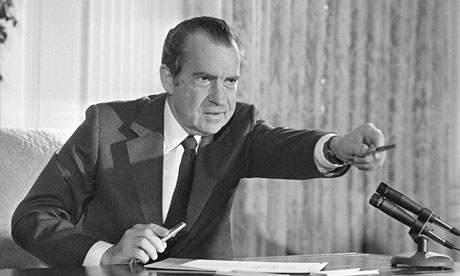
In June 1971, President Nixon declared a “War on Drugs.” He dramatically increased the size and presence of federal drug control agencies, and pushed through measures such as mandatory sentencing and no-knock warrants. Nixon temporarily placed marijuana in Schedule One, the most restrictive category of drugs, pending review by a commission he appointed led by Republican Pennsylvania Governor Raymond Shafer. In 1972, the commission unanimously recommended decriminalizing the possession and distribution of marijuana for personal use. Nixon ignored the report and rejected its recommendations. His first-year “War on Drugs” budget was $100 Million.
Each subsequent Presidential Administration “shifted” the “War on Drugs”:
In January 1977, President Jimmy Carter was inaugurated on a campaign platform that included marijuana decriminalization.
President Reagan in 1981 expands incarcerations by adopting a zero-tolerance, “Just Say No” campaign. “War on Drugs” success measurement was those incarcerated.

President George H.W. Bush during his 1989 “Crack speech” pledged one billion dollars to escalate he drug war because “we need more jails, more prisons, more courts and more prosecutors.” President H.W. Bush re-defined the irrational zero tolerance drug policies of the times that put ideology and politics above science and health.
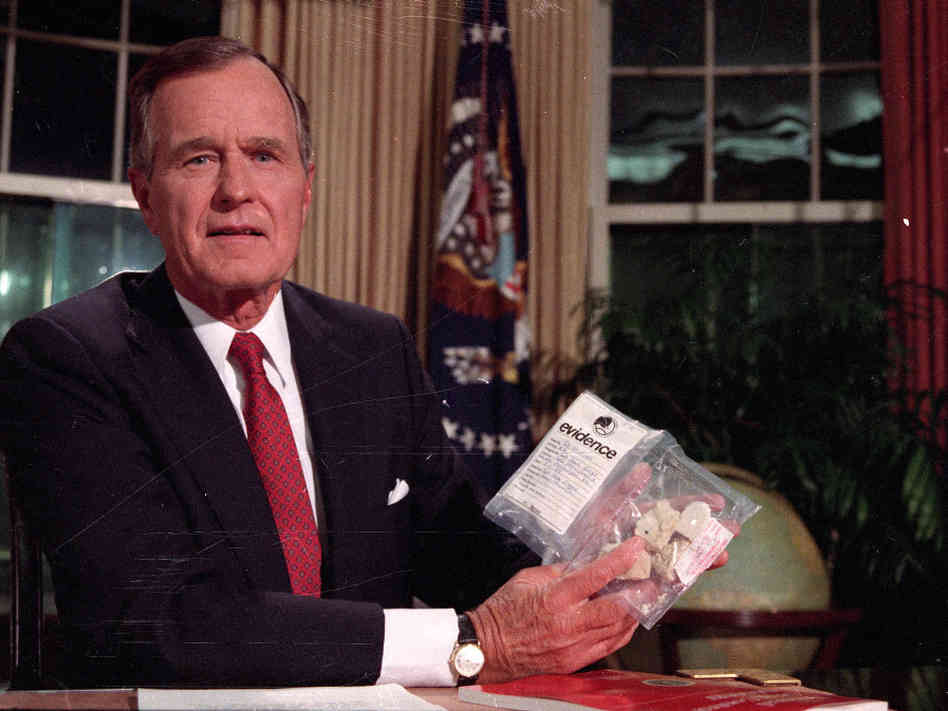
Efforts to eradicate opium at its source remains unsuccessful:
The 1994 President Clinton Administration orders a shift in policy away from the anti- drug campaigns of previous administrations. Instead the focus includes “institution building” with the hope that by “strengthening democratic governments abroad, [it] will foster law-abiding behavior and promote legitimate economic opportunity.”

President George W. Bush arrived in the White House as the drug war was running out of steam – yet he allocated more money than ever to it in 2009. His drug czar, John Walters, zealously focused on marijuana and launched a major campaign to promote student drug testing. While rates of illicit drug use remained constant, overdose fatalities rose rapidly. The era of George W. Bush also witnessed the rapid escalation of the militarization of domestic drug law enforcement. By the end of Bush’s term, there were about 40,000 paramilitary-style SWAT raids on Americans every year – mostly for nonviolent drug law offenses, often misdemeanors.

Politicians now (2014) routinely admit to having used marijuana, and even cocaine, when they were younger. President Barack Obama candidly discussed his prior cocaine and marijuana use: “When I was a kid, I inhaled frequently – that was the point.”
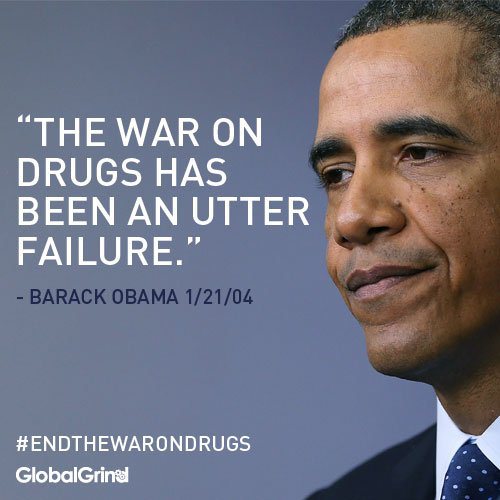
The assault on American citizens, however, has persisted through 2014. Despite advocating for reforms – such as reducing the crack/powder sentencing disparity, ending the ban on federal funding for syringe access programs, and supporting state medical marijuana laws – President Obama has yet to shift drug control funding to a health-based approach.
The “War on Drugs” continues to this day. By comparison, the U.S. spent $15.6 Billion in just one year, 2011, for the “War on Drugs.
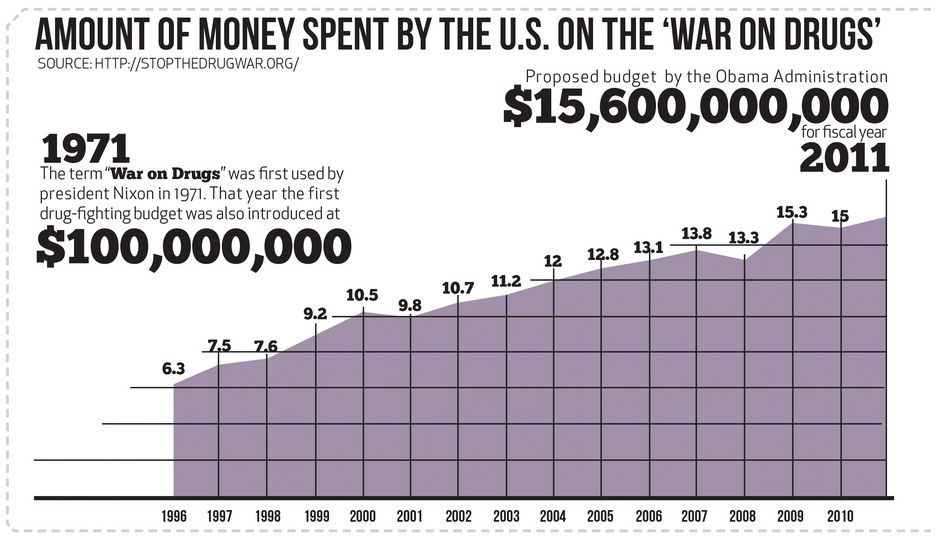
From 1970 through 2010 the “War on Drugs” has cost America $1.5 Trillion.
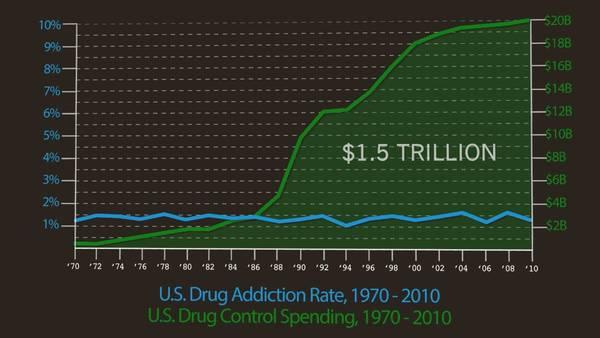
Despite the mega-trillion dollar spending, America’s addiction rate remains unchanged while the deaths as a result of prescription and illicit drugs remain at record levels.
Even more Controversy and Complication concerning opioids……
If the aforementioned isn’t enough controversy and complication concerning opioids, then we’ll add even more. During the past few years there’s been a bitter, anti-opioid campaign waged by some prominent academic institutions, pharmaceutical companies, professional organizations, and journals, almost in unison. This faction essentially claims that opioids shouldn’t be prescribed long term as they are unproven and unsafe. They claim that lack of long term opioid study along with potential dangerous opioid side affects including addiction, depression, and hyperalgesia are just cause to severely limit opioids to all.
The following 10-year Longevity Study conducted by a Pain Management Physician concludes chronic pain patients studied were functioning quite well after 10 or more years in opioid treatment.
Click on the link below to read the long term opioid study:
Opioid Treatment 10-year Longevity Study

Remember……
Opioids work by changing the way you feel pain.
The most important aspect of this is that “Opioids change you”.
Opioids will not fix your pain, heal your injury, or cure your disease.
Instead opioids will change everything about you so that your perception of pain is different.
Your wallet may feel the effects of opioid therapy as well. There is a wide range of costs for these medications with some having limited, or no insurance coverage. Check out this link Prescription Pricing to find out opioid pharmacy costs for most opioid medications.
You can also obtain average pharmacy pricing for monthly supply of most opioid medications at this Consumer Reports link.
The use of opioid medication is a balancing act, in which you the patient must ultimately decide if the pain relief experienced is “worth” the often unpleasant, occasionally debilitating side effects. The cause of your pain must be clearly understood and diagnosed by the time you start opioid medication therapy.
In the event your doctor should present a surgical option that will repair what’s causing your pain, then you must compare the outcomes of that surgical option versus longterm opioid medication therapy. The use of opioid medication longterm has dismal consequences at best.
I share my personal experience with opioid medication therapy with you to help you understand the complication opioids cause. The simple truth about taking opioids is that they will not take away your pain.
They are not your “magic” answer to managing longterm chronic pain. Opioid medication therapy requires your respect and understanding along with a team approach to managing your chronic pain and overall health with your Doctor
Another Option:
Another option is the surgically implanted spinal cord stimulator and, or surgically implanted intrathecal pump. These two devices may be an option to manage chronic pain while taking back your painweb.
Click on Tame The Pain to learn more about these options.
mypainweb “Surgery” and mypainweb “Timeline” will discuss these options along with several other surgical procedures I have had in an effort to reduce chronic pain and improve quality of life.